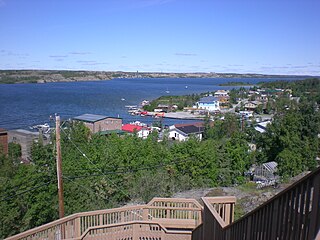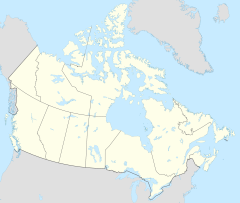
The Northwest Territories is a federal territory of Canada. At a land area of approximately 1,144,000 km2 (442,000 sq mi) and a 2016 census population of 41,790, it is the second-largest and the most populous of the three territories in Northern Canada. Its estimated population as of 2021 is 45,515. Yellowknife is the capital, most populous community, and only city in the territory; its population was 19,569 as of the 2016 census. It became the territorial capital in 1967, following recommendations by the Carrothers Commission.

Yellowknife is the capital, largest community, and only city in the Northwest Territories, Canada. It is on the northern shore of Great Slave Lake, about 400 km (250 mi) south of the Arctic Circle, on the west side of Yellowknife Bay near the outlet of the Yellowknife River.

Devolution is the statutory delegation of powers from the central government of a sovereign state to govern at a subnational level, such as a regional or local level. It is a form of administrative decentralization. Devolved territories have the power to make legislation relevant to the area, thus granting them a higher level of autonomy.

The commissioner of the Northwest Territories is the Government of Canada's representative in the Northwest Territories. Similar in certain functions to a lieutenant governor, the commissioner swears in the members of the legislative assembly, swears in members of the executive council, assents to bills, opens sessions of the legislative assembly, and signs other government documents such as Orders in Council.

The Northwest Territories Legislative Assembly, or Legislative Council of the Northwest Territories, is the legislature and the seat of government of Northwest Territories in Canada. It is a unicameral elected body that creates and amends law in the Northwest Territories. Permanently located in Yellowknife since 1993, the assembly was founded in 1870 and became active in 1872 with the first appointments from the Government of Canada.

Anthony Wilfred James Whitford is a retired Canadian politician, who served as the commissioner of the Northwest Territories from 2005 to 2010.

The history of Northwest Territories capital cities begins with the purchase of the Territories by Canada from the Hudson's Bay Company in 1869, and includes a varied and often difficult evolution. Northwest Territories is unique amongst the other provinces and territories of Canada in that it has had seven capital cities in its history. The territory has changed the seat of government for numerous reasons, including civil conflict, development of infrastructure, and a history of significant revisions to its territorial boundaries.
Weledeh was a territorial electoral district for the Legislative Assembly of the Northwest Territories, Canada.

Yellowknife South is a territorial electoral district for the Legislative Assembly of the Northwest Territories, Canada.

Kam Lake is a territorial electoral district for the Legislative Assembly of the Northwest Territories, Canada.

Yellowknife Centre is a territorial electoral district for the Legislative Assembly of the Northwest Territories, Canada.

Range Lake is a territorial electoral district for the Legislative Assembly of the Northwest Territories, Canada.
Elections NWT is an independent, non-partisan public agency responsible for the administration of territorial general elections, by-elections, and plebiscites in accordance with the Elections and Plebiscites Act. Elections NWT is headed by the Chief Electoral Officer, an officer of the Legislative Assembly of the Northwest Territories.
The Carrothers Commission, formally The Advisory Commission on the Development of Government in the Northwest Territories, was a commission set up by the government of Canada to study the future of government of the Northwest Territories. It was led by A.W.R. Carrothers, Dean of law at the University of Western Ontario. The other two members were Jean Beetz, law professor at the University of Montreal and a noted authority on the Canadian Constitution and John Parker, the Mayor of Yellowknife at the time and a mining engineer.

Government House, Regina, Saskatchewan, was constructed as a residence for the lieutenant governor of the North-West Territories, whose territorial headquarters were in Regina until the provinces of Saskatchewan and Alberta were created out of the Territories in 1905 and Regina became the capital of Saskatchewan.

The history of the Northwest Territories covers the period from thousands of years ago to the present day. Prior to European colonization, the lands that encompass present-day Northwest Territories were inhabited for millennia by several First Nations. European explorers and fur traders began to explore the region since the late-16th century. By the 17th century, the British laid claim to both the North-Western Territory and Rupert's Land; and granted the Hudson's Bay Company a commercial fur trade monopoly over the latter region.
This timeline of Yellowknife history summarises key events in the history of Yellowknife, a city in the Northwest Territories, Canada.
The 17th Northwest Territories Legislative Assembly was established by the results of the 2011 Northwest Territories general election on October 3, 2011. It was the 25th sitting of the Assembly in the territory's history. The Assembly was dissolved in 2015.
Julie Green is a Canadian politician, who was elected to the Legislative Assembly of the Northwest Territories in the 2015 election. She represents the electoral district of Yellowknife Centre. Green was re-elected in 2019. She was acclaimed to the Executive Council in August 2020 and was subsequently appointed Minister of Health and Social Services, Minister Responsible for Seniors and Minister Responsible for Persons with Disabilities.



















